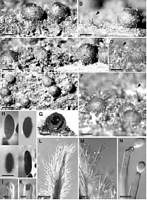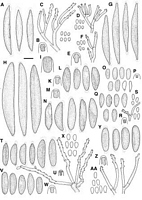|
 Rosellinia hughesii Rosellinia hughesii
BiostatusPresent in region - Indigenous. Endemic
Images (click to enlarge)
Caption: Fig. 16 Rosellinia hughesii. A-F, Stromata, A-D, F, showing synnemata (arrows); G, Vertical
section of stroma, note on the left side stroma shell and detached perithecium; H, As | 
Caption: Fig. 8 A-D, Rosellinia arcuata, PDD 41969: A, Ascospores; B, Ascus apical ring; C,
Conidiophores and conidia on the host; D, Conidiophores and conidia on OA; E-G, R.
freycinetiae, PDD 20580: E, Ascus a |
Article: Petrini, L.E. (2003). Rosellinia and related genera in New Zealand. New Zealand Journal of Botany 41(1): 71-138 (http://www.rsnz.org/publish/abstracts.php).
Description: Subiculum persistent, dark brown, wiry, with synnemata. Stromata (750)850 ± 60(950) µm
high, (700)1007 ± 194(1250) µm wide (n = 10), cupulate, subglobose to globose, dark brown,
black around the ostioles, solitary, often crowded, when young completely embedded in the
subiculum, gradually emerging while growing. Ostioles finely papillate. Ectostroma 75-100
µm thick, black, hard, brittle. Entostroma cream, confined to base, absent in mature material.
Perithecia detached and collapsed in mature material. Ascus apical rings (4.8)5.9 ± 0.5(6.7)
µm high, upper width 4.3-4.8 µm, lower width 2.8-3.8 µm (n = 10), J+, dark blue. Ascospores
(17.3)20.5 ± 1.4(24) mm long, (6.7)7.6 ± 0.5(8.6) µm wide (n = 60), inequilaterally
ellipsoidal with one flat side, often broadly rounded, dark brown, with straight germ slit
running over the whole spore length. Synnemata up to 1000 µm high, conidia 7-8 x 3-4.5 µm.
ANAMORPH: Dematophora.
Habitat: HOST: Hoheria populnea.
MATRIX: Decorticated, heavily decomposed wood.
Notes: ETYMOLOGY: In honour of the mycologist S. J. Hughes, who collected the paratype.
NOTES: Rosellinia hughesii is characterised by its Dematophora anamorph and the shape and
size of its ascospores with a long germ slit. Only ascospores without slimy sheath or caps were
observed. This, however, may be due to the age of the material. It would not be surprising in
the future to find material having ascospores with slimy sheaths or caps.
Most Rosellinia species with a Dematophora anamorph have long, slender ascospores with a
very short straight germ slit as seen in R. arcuata. In this respect, R. hughesii resembles R.
buxi Fabre, as both have similar ascospore shapes. The latter, however, has larger ascospores
with a short germ slit, taller stromata, and smaller synnemata. The size of conidia is almost the
same in both species (Petrini 1993). Rosellinia hughesii differs from R. gisbornia by its
persistent dark brown subiculum with the Dematophora conidial state, larger stromata, and
smaller ascospores, and from R. mammaeformis by the larger stromata, persistent subiculum,
and anamorph.
|